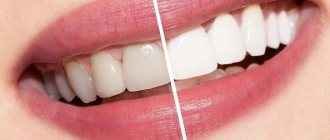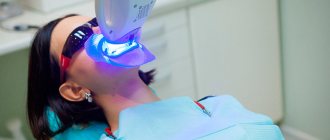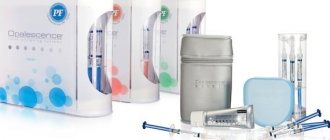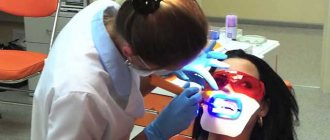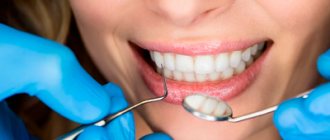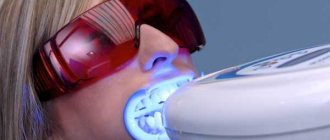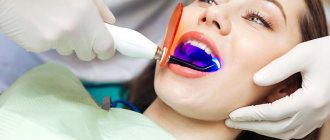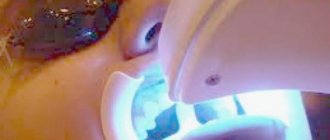Author of the article:
Soldatova Lyudmila Nikolaevna
Candidate of Medical Sciences, Professor of the Department of Clinical Dentistry of the St. Petersburg Medical and Social Institute, Chief Physician of the Alfa-Dent Dental Clinic, St. Petersburg
Whitening a pulpless tooth differs significantly from the procedure performed on healthy teeth. In the usual sense, the creation of a snow-white smile occurs with the help of a special gel, where the active substance is hydrogen peroxide in various concentrations. The composition is applied to the surface of the enamel and left for some time. In this case, additional activators can be used - laser, ultraviolet, cold light from a LED lamp, and so on. All this is necessary for oxygen to begin to be released from the gel, which discolors the yellow pigment.
Whitening a dead tooth is also done using hydrogen peroxide, but the procedure itself is radically different. Let's figure out why it is needed and how the treatment works.
Causes of darkening of pulpless teeth
The procedure is carried out solely at the request of the patient, as it mainly serves only an aesthetic function. Most often, forced lightening is required for dead incisors or fangs, since they are always visible, and if the shade of the enamel differs even by a couple of tones, it will be noticeable.
Teeth from which the pulp, that is, a collection of blood vessels and nerve endings, have been removed are considered dead. It is because of them that we feel pain, which warns of the presence of problems: the development of caries, internal trauma, etc.
In the absence of pulp, hard tissues cease to receive nutrition. What we see is no longer a tooth, but its shell, like a tree without roots. Such an incisor or molar will most likely not look the same, much less function. The consequences begin to be noticeable about a month after pulp removal. Dentin and enamel, as well as the main mineral part of the tooth, weaken and dry out. All these processes make the structure of solid tissue more porous.
Without constant replenishment, the tooth becomes defenseless and what was previously not a particular problem becomes more dangerous for it. It better absorbs pigments from food, for example, coffee, tea, alcohol, colored lemonades, berries and fruits, chocolate and other products with a high content of dyes. A pulpless tooth is like a sponge, so dyes accumulate in it faster, which means that after some time its shade begins to differ from the general tone of other teeth. If this is the reason for the color change, then standard whitening with an active gel is performed.
But there are also more complex problems when a canine or molar darkens from the inside. This happens precisely because of the removal of the pulp. Usually, those nerves that are damaged for one reason or another or interfere with the normal treatment of diseases such as tooth decay are removed. This removal may damage blood vessels, causing bleeding inside the canal. The dentin of a healthy tooth stains even more quickly than the enamel of dead hard tissue. Due to bleeding, the tooth becomes red and sometimes has a purple tint. In this case, standard bleaching will not help, since it mainly affects the outer layers of the fabric.
What methods of whitening are there and why are there so many of them?
Each manufacturer has its own classification, but simply, all whitening systems can be divided into two types:
- Office (or “clinical”) whitening, which is performed by a dentist in a clinic.
- At-home whitening designed to whiten your teeth yourself.
In-office teeth whitening systems
Office systems differ from home systems in having a higher concentration of bleaching agent (hydrogen peroxide or carbamide), so they whiten teeth quickly and significantly better.
Only a dentist can perform such whitening.
Bleaching systems differ in the method of activation of the bleaching composition:
- photochemical - activation with ultraviolet, LED lamp or laser light
- chemical (lampless) – activation due to a chemical reaction
If you need to get a snow-white smile QUICKLY , then you should choose in-office teeth whitening systems.
Home teeth whitening systems
At-home systems are most often used to maintain the results of in-office whitening and are offered as:
- trays that hold the whitening gel
- whitening strips , pencils and toothpastes
If in-office whitening is not recommended for medical reasons, professional at-home teeth whitening can be used. A course of home whitening will give an effect close to that in the office, but still not the same.
Philips offers two professional home teeth whitening systems, ZOOM DayWhite and NiteWhite.
How to whiten a darkened tooth
For single whitening, none of the home methods will work, be it professional gels with trays or traditional methods. You should not risk the health of your teeth; if one of them becomes very dark, contact your dentist, a specialist will select the right course of treatment. The procedure must be carried out so as not to affect the remaining teeth. Or if you whiten everything at once, the dead tooth needs to be given special attention. This is only possible in an office setting.
Hydrogen peroxide will also serve as a bleaching agent; when the chemical reaction is activated, oxygen neutralizes pigments in the enamel and even penetrates into dentin. It is important to work with peroxide carefully. If handled improperly, peroxide can damage the enamel or cause a chemical burn to the mucous membrane. The only thing that can be done here is to provide maximum protection and reduce the concentration of the substance. In a whitening gel for standard procedures, the mass fraction of the active substance reaches 40%. This is enough to quickly get rid of yellowness, but not damage the enamel. For pulpless teeth, such a concentration will be excessive, so gels with a minimal peroxide content are used here.
Before you begin the procedure, the doctor will prepare you for it; this is necessary for safety. A special retainer is placed in the mouth, and the gums are treated with varnish, which forms a protective film on the teeth. After all, a gel is applied to the dead tooth; a laser is most often used to activate the reaction, which is why active oxygen begins to quickly release from the composition - this reduces the time of exposure to chemicals. It is the laser that allows targeted treatment of one tooth, so it is better suited than photo-bleaching, which is designed to lighten the entire row.
For internal damage, intracanal bleaching is used. The principle of the procedure is very simple. The active gel is placed inside the root canal, which is previously cleared and expanded. In such cases, the pulp is precisely removed, since the tooth becomes very sensitive and vulnerable. For intracanal lightening, use a gel with a peroxide concentration that does not exceed 20%. In this option, whitening takes a significant amount of time - usually several weeks. The canal opening is closed with a temporary filling, leaving the gel inside the tooth. After the tissues have changed color to the desired color, a permanent filling is placed on the tooth.
How harmful is whitening a dead tooth?
All types of whitening are, to one degree or another, harmful to teeth, both healthy and pulpless. The latter are much weaker, so the procedure is more destructive. On the other hand, such a tooth will not last more than five years and will still collapse. In this case, there are two options: install a crown or make an implant.
A crown is the most popular option due to its reasonable cost and simplicity. This is a permanent prosthesis that completely follows the shape of the tooth and allows you to restore its chewing and aesthetic functions. In most cases, ceramics or its combination with metal are used to produce crowns. It is possible to install a crown without an implant only if the dentist managed to completely preserve the roots and at least 50% of the crown of the tooth.
An implant is a more serious design than a crown. This is an almost complete replacement of the main part of the tooth and its root system. The most popular implants are made from titanium alloys, but other materials are also used for their production. The product is implanted into the bone tissue and, after complete healing, becomes an inseparable part of the jaw and a support for the crown. Usually people strive to keep their own teeth for as long as possible without replacing them with dentures. And the main reason is not the high cost of the operation.
For quite a long time, it was believed that your own teeth are always better than artificial ones. Unfortunately, today it is almost impossible to maintain a healthy smile until old age; sooner or later the hard tissue weakens and begins to crumble. This happens around the age of fifty. So in many cases it is necessary to resort to implants; they are even needed to fix removable dentures. But the fact is that with age, the body tolerates such operations less well.
Therefore, if you have had the pulp removed and the tooth has turned black, one of the reasonable solutions would be to replace it with an implant, without wasting time and money on whitening without replacing it in time. But in any case, the dentist always has the final say.
How to keep your teeth healthy
To avoid unpleasant situations as much as possible, carefully monitor your dental health. Professional products from the ASEPTA series will help you with your care. In the line you will find remineralizing pastes that restore the health of enamel, rinses that prevent gum inflammation and other effective products.
Strengthen the enamel so it doesn't hurt!
During preparation for whitening, the dentist may recommend a course of remotherapy to strengthen the enamel and reduce its sensitivity.
The procedure is done in a clinic and continues independently at home for 14 days. Remotherapy can also be prescribed after teeth whitening.
We talk about remotherapy in the article What causes tooth sensitivity and will remotherapy help me?
Philips , which offers ZOOM whitening, for maximum safety and painlessness of the procedure, includes a special Relief gel in its whitening kits, which is applied to the teeth before and after the procedure.
Relief Gel strengthens enamel and reduces sensitivity during and after whitening.
See how Relief Gel protects your teeth.
Now that you are ready to whiten your teeth, let's figure out what whitening methods exist and what each of them is intended for.
Clinical researches
Clinical experiments with the use of the Asepta series of products, conducted at the Ryazan State Medical University named after Academician I.P. Pavlova of the Ministry of Health and Social Development of the Russian Federation (GBOU VPO RyazSMU Ministry of Health and Social Development of Russia) have proven that the use of Asepta line products results in a decrease in complaints of discomfort, but bleeding persists when brushing teeth.
On examination, hyperemia and bleeding of the gingival papillae are noted. On the 7th day, complaints of gum bleeding persisted in 4 patients. Upon examination, a decrease in hyperemia and swelling of the gums was noted, but bleeding persisted upon probing. On day 14, 2 patients continued to complain of bleeding gums when brushing their teeth; upon examination, a significant decrease in hyperemia and swelling of the gums was noted. After the final application of the gel with propolis, normalization of clinical manifestations was revealed, which is manifested by the absence of bleeding during brushing and probing.
Sources:
- Clinical experience in using the Asepta series of products Fuchs Elena Ivanovna Assistant of the Department of Therapeutic and Pediatric Dentistry State Budgetary Educational Institution of Higher Professional Education Ryazan State Medical University named after Academician I.P. Pavlova of the Ministry of Health and Social Development of the Russian Federation (GBOU VPO RyazSMU Ministry of Health and Social Development of Russia)
- Report on determining/confirming the preventive properties of toothpaste “ASEPTA PLUS” GENTLE WHITENING” Author: doctor-researcher A.A. Leontyev, head Department of Preventive Dentistry, Doctor of Medical Sciences, Professor S.B. Ulitovsky First St. Petersburg State Medical University named after. acad. I.P. Pavlova, Department of Preventive Dentistry
- Clinical and laboratory assessment of the influence of domestic therapeutic and prophylactic toothpaste based on plant extracts on the condition of the oral cavity in patients with simple marginal gingivitis. Doctor of Medical Sciences, Professor Elovikova T.M.1, Candidate of Chemical Sciences, Associate Professor Ermishina E.Yu. 2, Doctor of Technical Sciences Associate Professor Belokonova N.A. 2 Department of Therapeutic Dentistry USMU1, Department of General Chemistry USMU2
- Report on the determination/confirmation of the preventive properties of personal oral hygiene products “ASEPTA PLUS” Remineralization doctor-researcher A.A. Leontyev, head Department of Preventive Dentistry, Doctor of Medical Sciences, Professor S.B. Ulitovsky First St. Petersburg State Medical University named after. acad. I.P. Pavlova, Department of Preventive Dentistry
Preparation for the procedure
Initially, the doctor takes an x-ray. Then the mucous membrane in the mouth and gums are treated. They are coated with varnish to protect them from the gel. Next, the mixture is applied to the damaged molar. In order for it to actively start working, it is exposed to laser or ultraviolet light.
If darkening of the teeth occurs due to internal hemorrhage in the canals, then the doctor must initially clean them. This may require opening them. Next, the active substance is injected into the canals and a filling is placed.
So a person can pass a certain time until the color of the enamel becomes natural. Then a permanent filling is placed.
Restoration at home
Not everyone can visit a dentist to whiten their enamel. Not everyone has such an opportunity and desire. Therefore, in some cases, whitening can be done at home.
To read: Solid crowns: manufacturing stages
You can use mouthguards for this. These are original covers for teeth made of plastic or silicone. These trays are filled with gel and placed on the teeth.
Other techniques can also be used. They are used in conjunction with clinical procedures. When a patient consults a doctor, he applies a paste to his surface, which contains hydrogen peroxide and sodium.
This composition must be carried for a certain time, and then consult a doctor again. The technique is effective if the darkening is small.

